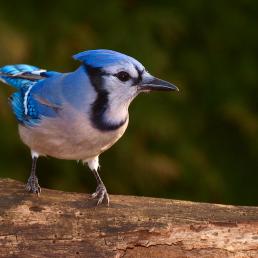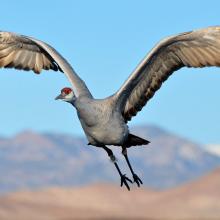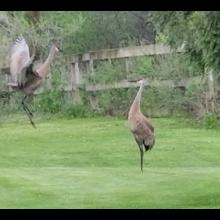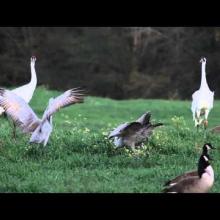

Join BirdNote tomorrow, November 30th!
Illustrator David Sibley and actor H. Jon Benjamin will face off in the bird illustration battle of the century during BirdNote's Year-end Celebration and Auction!
When writer Lee Ann Roripaugh visited the annual staging grounds of Sandhill Cranes in Nebraska, she was in awe of the birds. During their spring migration, hundreds of thousands of cranes roost on sandbars in the Platte River. The sound and sight of these birds is breathtaking; Lee Ann captures it beautifully in this poem:
:: #sandhillcranes #string of beads ::
sizzle of orange :: lightning / the corrugated :: tin blind a gaunt bell
clanging in the wind and rain :: curious deer near to see
~
roosting overnight :: in clusters on the river’s :: sandbars / cranes stirred to
call and response by the storm :: say hello (hello) hell-oh
~
scribbled warble of :: cranes graffiti night’s water :: a river otter’s
sleek whiskered head interrupts :: the river’s tense murmuring
~
train whistle’s blurred smear :: curlicued by coyotes’ yip and wail :: the wood-block chortling
of cranes gets frenetic / as :: sun’s wobbly gold yolk slides up
~
thousands of sandhills :: helix off sandbars into :: spirographed kettling
football stadium loud / iced :: river exhales puffs of fog
~
a whooping crane takes :: wing from the cornfield in snow :: ukiyo-e
cranes in snow / moon craning :: the river trills all night long
~
obfuscatory :: crooning slices through the mist :: filaments of cranes
unraveling / shaggy yarn :: from a woolly skein of fog
~
a flyover plane :: cranes burble silver water :: chirping lotto balls
oil empire’s blinking neon :: signage strobes the horizon
BirdNote®
Lee Ann Roripaugh: String of Beads
Written by Mark Bramhill
Mark Bramhill: This is BirdNote.
[Floaty, expectant music]
When writer Lee Ann Roripaugh visited the annual staging grounds of Sandhill Cranes in Nebraska, she was in awe of the birds. During their spring migration, hundreds of thousands of cranes roost on sandbars in the Platte River. Lee Ann had been invited to a retreat where writers could witness this natural wonder.
Lee Ann Roripaugh: And so we would go out every morning to see the cranes take off from the sand bars along the Platte River, and then we would return at dusk to see them fly back in to settle in for the night. And that was so incredible and unforgettable.
Mark Bramhill: The sound and sight of these birds is breathtaking; Lee Ann captures it beautifully in this poem:
Lee Ann Roripaugh:
:: #sandhillcranes #string of beads ::
sizzle of orange :: lightning / the corrugated :: tin blind a gaunt bell
clanging in the wind and rain :: curious deer near to see
~
roosting overnight :: in clusters on the river’s :: sandbars / cranes stirred to
call and response by the storm :: say hello (hello) hell-oh
~
scribbled warble of :: cranes graffiti night’s water :: a river otter’s
sleek whiskered head interrupts :: the river’s tense murmuring
~
train whistle’s blurred smear :: curlicued by coyotes’ yip and wail :: the wood-block chortling
of cranes gets frenetic / as :: sun’s wobbly gold yolk slides up
~
thousands of sandhills :: helix off sandbars into :: spirographed kettling
football stadium loud / iced :: river exhales puffs of fog
~
a whooping crane takes :: wing from the cornfield in snow :: ukiyo-e
cranes in snow / moon craning :: the river trills all night long
~
obfuscatory :: crooning slices through the mist :: filaments of cranes
unraveling / shaggy yarn :: from a woolly skein of fog
~
a flyover plane :: cranes burble silver water :: chirping lotto balls
oil empire’s blinking neon :: signage strobes the horizon
Mark Bramhill: The title, “string of beads” refers to the poetic form that Roripaugh created:
Lee Ann Roripaugh: These are, essentially, tanka that are strung together like beads. So it's an homage to Heian-period Japanese women writers.
Mark Bramhill: A tanka is a traditional Japanese form of poetry that’s syllabic in nature. So, you have a line with five syllables, then seven, then five — which you might recognize as a haiku — followed by two more seven-syllable lines.
Lee Ann Roripaugh: Frequently tanka do engage with the natural world. These were tanka that I also wanted to blend and not compartmentalize the natural world with technology — that's kind of a false binary.
Mark Bramhill: This blending of man and nature is evident in the following poem, recounting the view during long drives.
[Solemn pedal steel guitar music fades in]
Lee Ann Roripaugh:
:: #ontheroad #string of beads ::
hotel’s liminal :: blur / anywhere-ness / any- :: one-ness / then merges
back into the tricky on- :: ramp of your own lonesome skin
~
propane deep blue clouds :: with gaslit underbellies :: reflected back in
glass-bright sloughs / red-winged blackbirds :: studding the mile marker posts
~
cherry pit stop gas :: and casino / minnows and ammo :: bait worms out back!
fueling on the precipice :: of springtime’s epoch ellipse
~
semiology :: spink → wakonda → vanitas → :: overpass may be
icy → jesus saves → BOW-X-HUNT → :: tea adult supercenter
~
little birds stipple :: a milky sky / sticky leaves’ :: wet yellow makes the
center line brighter / rain-drenched :: heads of sunflowers sadder
~
busy buzz of snow : like insects in a hurry :: an agitation
of snow geese burst white kernels :: popcorning in stubble corn
~
filaments of geese :: and cranes cross-stitching the mist :: down I-29
squeaky dry-erase markers :: rubbing on the whiteboard sky
~
the morning’s thin rime :: of soft frost scraping off in :: slow spiraling curls
like vegetable skins rinding :: off a peeler’s sharp bride blade
~
snow dragons lick the :: interstate with frostbitten :: breath / skidoo-ing through
stunned tundra with no regard :: for day-glo orange safety cones
Mark Bramhill: The poem isn’t recounting one single drive — it’s a collage, showing the passing of time.
Lee Ann Roripaugh: So like, sometimes there’s those little snow-dragons on the ground, those little flurries. Sometimes you can see the seasons change when the Red-winged Blackbirds appear again, or, you know, around November, the Snow Geese sort of clustering in the stubble corn.
It's really kind of about that sense of blurring of the seasons when you're kind of moving through the same highways or interstates over time. But also that, that sense of being in in-between space. You haven't arrived, you're not where you're trying to be, and you're also not home. And that feeling of sort of being lonely, cause you're not quite settled. But then there's like so many interesting things to see along the way.
And of course, the birds are on the move too — they're like, they're like going places!
Mark Bramhill: You can hear more poetry about our feathered friends on our website, BirdNote dot org. I’m Mark Bramhill.
###
Producer: Mark Bramhill
Managing Editor: Jazzi Johnson
Managing Producer: Conor Gearin
Content Director: Jonese Franklin
Bird sounds provided by The Macaulay Library of Natural Sounds at the Cornell Lab of Ornithology, Ithaca, New York. Sandhill Crane ML164684 recorded by Gerrit Vyn, Sandhill Crane ML89890691 recorded by Paul Marvin, Sandhill Crane ML56580061 recorded by Darrell Peterson, Sandhill Crane ML172877841 recorded by Connor Cochrane, Sandhill Crane ML164681 recorded by Gerrit Vyn, Snow Goose ML137672671 and ML70994921 recorded by Paul Marvin, and Red-winged Blackbird ML94230 recorded by Wil Hershberger.
Music: Grand Pianola Music I by John Adams and London Sinfonietta; Riga Black by Chuck Johnson
BirdNote’s theme was composed and played by Nancy Rumbel and John Kessler.
© 2024 BirdNote April 2024
Narrator: Mark Bramhill
ID# RoripaughL-01-2024-04-16 RoripaughL-01





